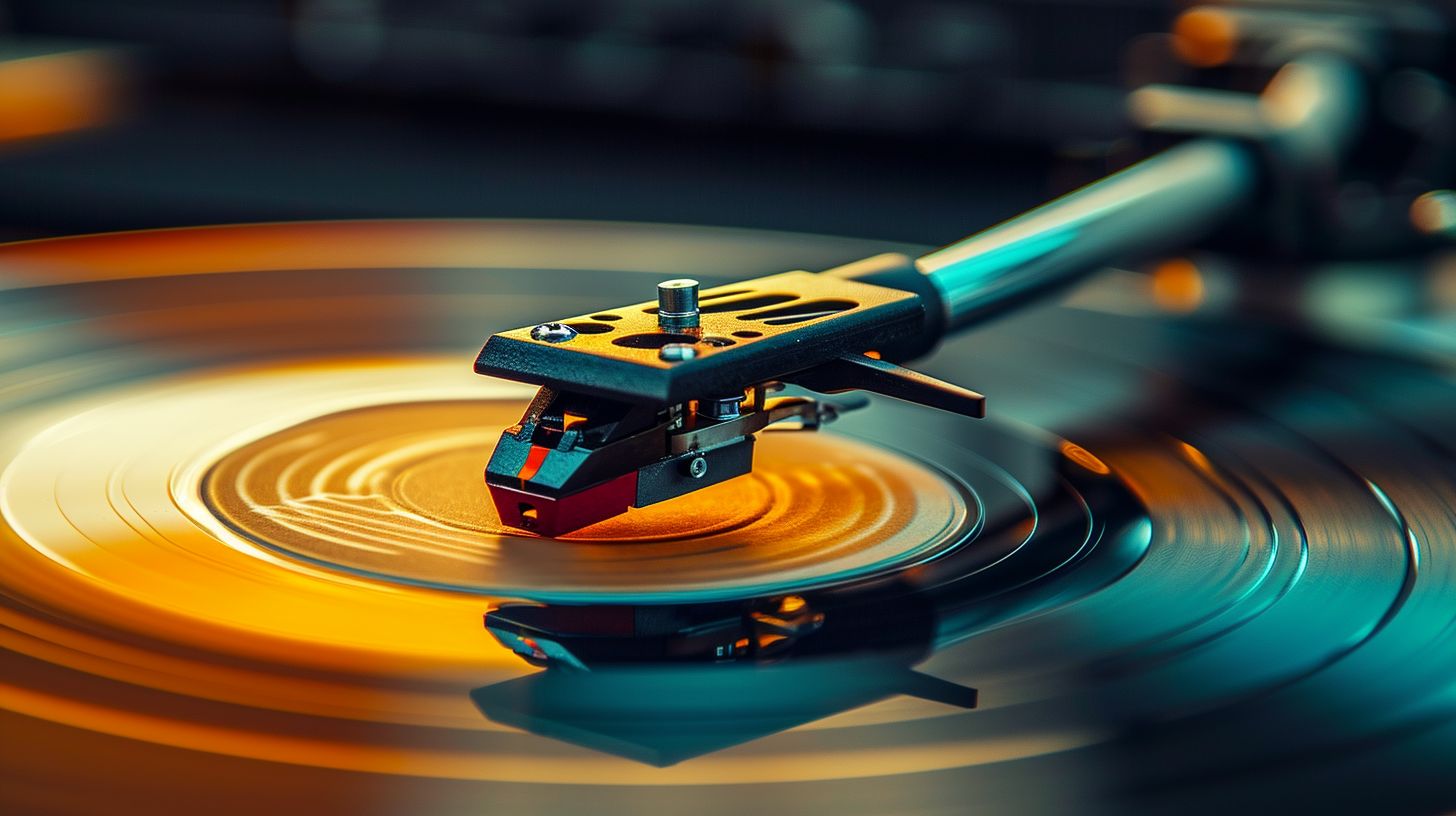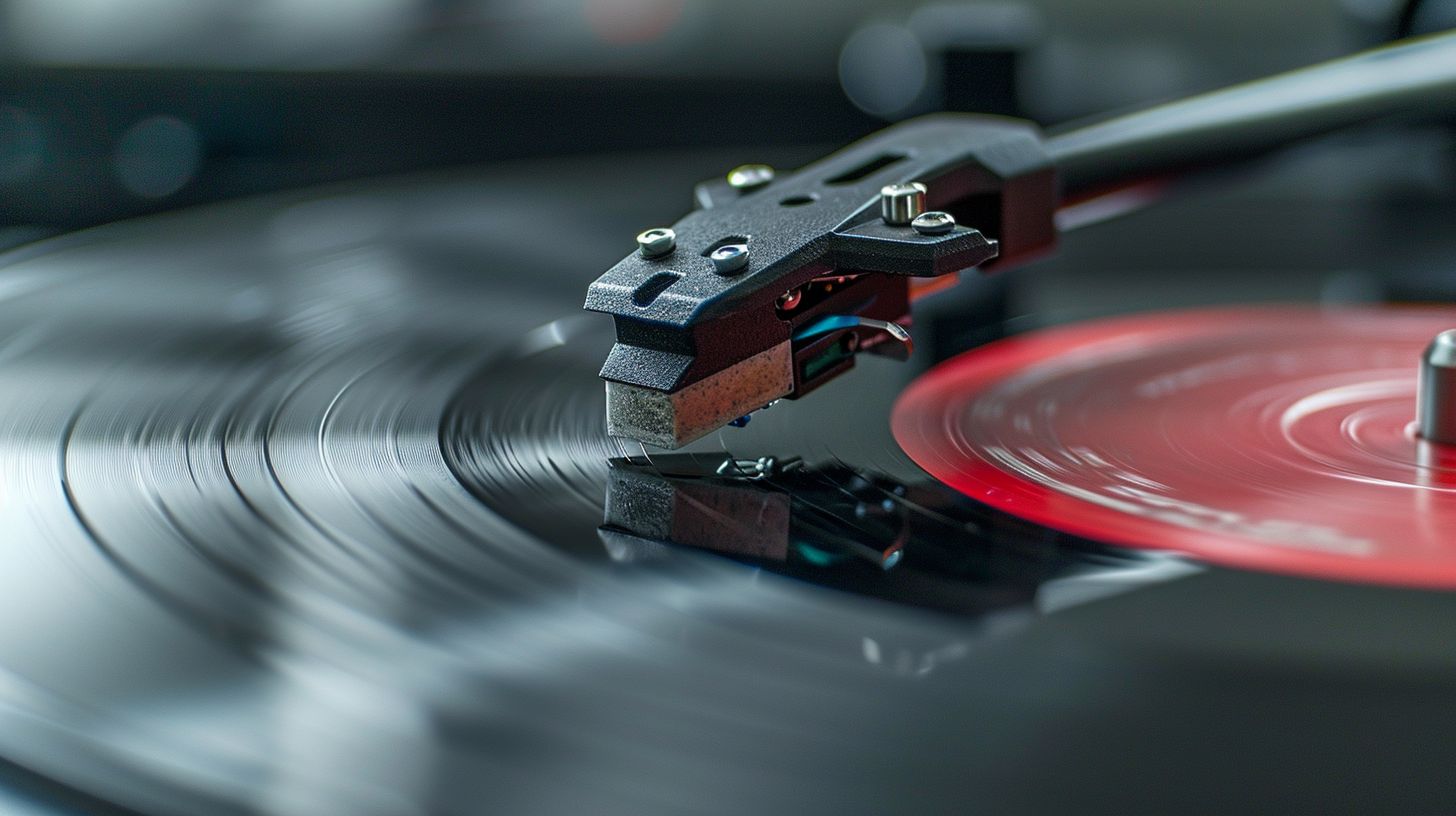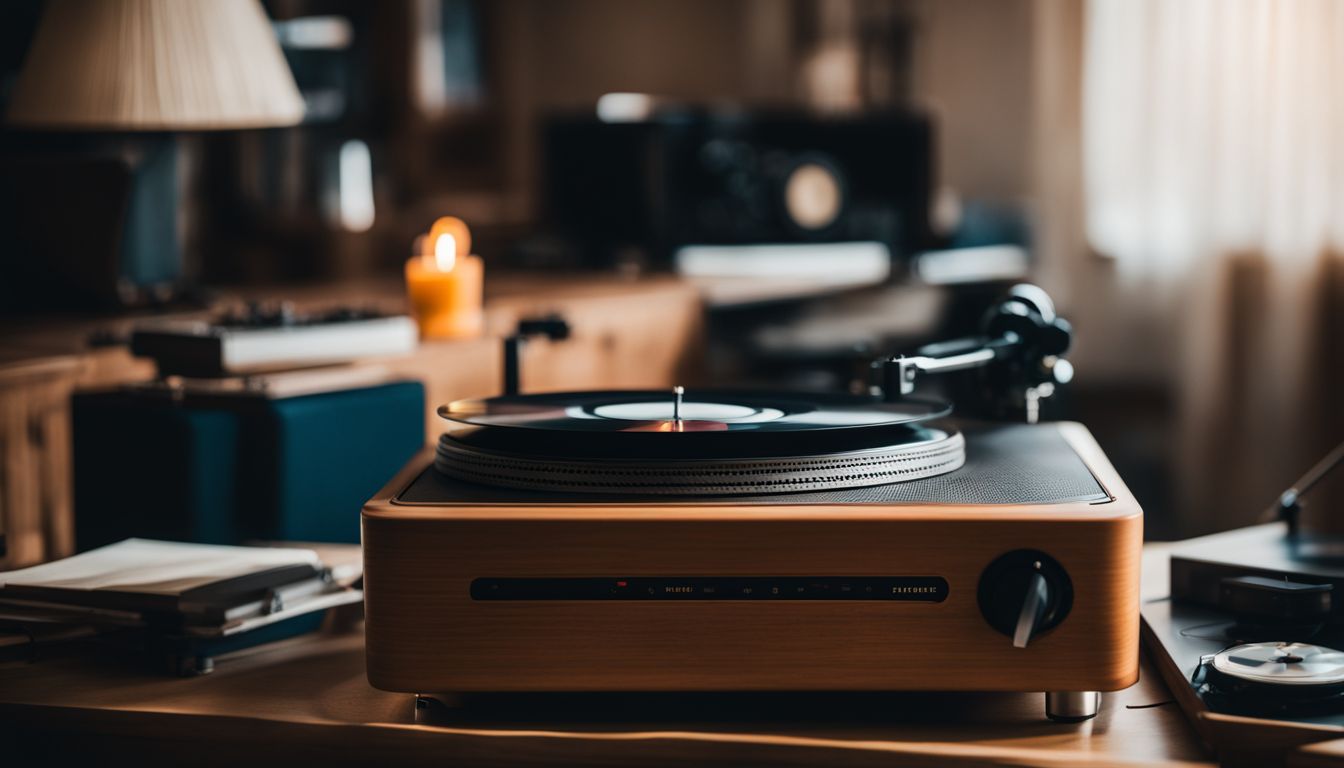Ever wondered how those groovy vinyl records fill the room with music? It all starts with the stylus, or needle, that reads every sound etched into a record’s surface. This article will unwrap the magic behind record players and show you exactly what happens from groove to groove.
Dive in for a spin!
Key Takeaways
- Record players turn mechanical vibrations from vinyl grooves into electrical signals. These signals are amplified to produce sound.
- Key components of a record player include the platter, motor, tonearm, stylus (needle), counterweight, and preamp.
- The phonograph by Thomas Edison was the first device that could both capture and reproduce sounds mechanically. It is the ancestor of modern vinyl record players.
- Turntables may be belt-drive or direct-drive, with each type offering distinct advantages. Belt-drives are quieter, while direct-drives have higher torque for DJing.
- Record player cartridges can be moving magnet or moving coil types. They convert needle vibrations into electrical signals for amplification.
Evolution of Record Players
The journey of record players from their inception to the modern turntable is a fascinating tale. It’s a story of innovation and engineering. It’s a story that begins with Thomas Edison’s phonograph. It evolves through Emile Berliner’s gramophone. It culminates in the sophisticated audio devices we enjoy today.
The Phonograph: Grandfather of the Modern Record Player
Thomas Edison unveiled the phonograph in 1877, and it quickly turned heads as an innovative way to capture and replay sounds. This device featured a rotating cylinder wrapped in tinfoil, which was etched with grooves by a needle as users spoke or sang into a horn.
When they cranked the handle to play it back, the stylus retraced these grooves. It vibrated to reproduce the recorded sound through the same horn.
The phonograph marked a pivotal moment in audio history. It led us from live performances being the only way to enjoy music to personal sound experiences at home. This invention laid down the basic principles of mechanical sound reproduction. These principles evolved over time. Cylinders turned into discs and styluses were refined. Eventually, electrical signals transformed how we hear music today on modern record players.
Edison’s groundbreaking work set off a chain reaction of innovation that is still unfolding more than a century later.
The Gramophone: Father of the Modern Record Player
The invention of the gramophone marked a monumental leap in audio technology, shaping the future of music consumption. It introduced the idea that sound could not only be captured but also reproduced with impressive clarity.
Inventors took inspiration from its mechanical genius. They used the inspiration to improve and create devices that deliver rich audio. This eventually led to the modern record players we recognize today.
The gramophone used flat disc records, unlike its predecessor, which used tinfoil cylinders. This made storage and production much easier. It also paved the way for mass media distribution.
The materials evolved too—from hard rubber or shellac records to vinyl discs—enhancing durability and audio fidelity. These advancements brought sophisticated components to the turntable. For example, stylus needles were designed to pick up sound vibrations etched into grooves on records. They were made not to damage the records.
This innovation forever changed how people enjoyed music at home or on a massive scale in public venues.
From Gramophone to Turntable: transitioning smoothly from this key development brings us to our next topic. It’s about how record players continued to evolve. Now, DJs around the world swear by direct-drive turntables, which spin tunes at every party.
From Gramophone to Turntable
Record players have come a long way since the days of the gramophone. Early devices used large horns to amplify sound and were purely mechanical, relying on a hand crank to spin records.
As electricity became widespread, these machines evolved into electric turntables. They had built-in speakers and sleeker designs. Turntables soon became popular in homes for their convenience and better sound quality.
Today’s turntables blend nostalgic design with modern technology. They feature USB ports for digitizing music. The precision-engineered components improve audio fidelity. Also, there are options for both casual listeners and professional DJs.
Collectors appreciate the ability to play mono pressings on turntables. The turntables are designed with stereo capability in mind. They also enjoy advancements that make listening more engaging than ever before.
Modern record players offer something special for every music enthusiast. Whether it’s for a trip down memory lane or to experience high-quality vinyl playback.
Components of a Record Player
Delve into the anatomy of a record player and you’ll uncover a harmonious blend of mechanical artistry and acoustic science. Each component is ingeniously designed. It plays a pivotal role in transforming grooves on vinyl into audible masterpieces.
Turntable Platter
The heart of the record player’s magic lies in its turntable platter, spinning the vinyl at a steady pace to bring music to life. These platters are designed for stability and reduced vibration. They are crafted from materials such as heavy aluminum or acrylic. This provides a clear and uninterrupted sound experience.
The choice of a heavier platter is deliberate; it helps to minimize distortion and maintain precision in speed for that perfect pitch.
Sitting atop the platter, you’ll find the slip mat, crucial for cushioning the record and reducing any slippage during play. Underneath, an efficient motor commands the rotation with either an AC or DC current. This sets up everything necessary for the tonearm and stylus to trace those masterful grooves etched into each vinyl disc.
Moving on from this centerpiece brings us closer to another essential element. Belt-Drive and Direct-Drive systems each bring unique characteristics to your listening adventure.
Belt-Drive vs. Direct-Drive
The debate between belt-drive and direct-drive turntables centers on how the platter receives its spin. Let’s dive into the specifics with a concise comparison.
| Belt-Drive Turntables | Direct-Drive Turntables |
| Use an elastic belt to connect the motor to the platter | Have the motor directly attached to the platter |
| Known for lower noise and reduced vibration | Offer higher torque and speed stability |
| Ideal for casual listening due to cleaner sound quality | Preferred by DJs for quick starts and stops |
| Audiophiles appreciate the reduced motor interference | Favored by those requiring consistent speed for scratching and mixing |
| More susceptible to belt wear and elasticity issues over time | Generally more durable with fewer parts that can wear out |
| Often come with a lower price tag | Can be pricier due to the complex direct-drive mechanism |
Determining which one to choose often boils down to what you value most in your vinyl listening experience. Belt-drive models provide an audible clarity that resonates with purists. Direct-drive units offer the reliability and control essential for a DJ’s performance.
Motor
The motor in a record player plays a pivotal role, much like the heart does in our body. It sets the platter in motion and, depending on whether it’s an AC or DC motor, determines how smoothly your records will spin.
A high-quality motor guarantees that the stylus accurately picks up every beat and note from the master recording as the vinyl disk rotates. It has precision-engineered parts.
Keeping this critical component in top shape is essential for any record player to function properly. Regular maintenance not only prolongs its life but also preserves the rich sound quality of your vinyl collection.
Moving forward to speed selectors, they work hand-in-hand with the motor to adjust how fast or slow your records play. Getting them right can make all the difference. It’s the difference between pitch-perfect tunes and off-key disappointments.
Speed Selectors
Moving on from the motor that drives your record player, let’s talk about speed selectors. These handy switches give you control over how fast the platter spins, accommodating different types of records.
Most commonly, you’ll find options for 33⅓ RPM and 45 RPM—essential for playing long-playing (LP) albums or single hits, respectively.
Speed selectors are crucial for achieving the perfect sound. They ensure that each groove spirals correctly under the stylus. This produces either monophonic or stereo sound, precisely as intended.
Setting the right speed is key to unlocking the full potential of any vinyl experience. Whether you’re mixing a stereo blend on DJ turntables or enjoying high-fidelity audio at home.
Stylus (aka Needle) and Tonearm
After setting the correct speed, the magic of music playback really kicks in with the stylus and tonearm. The stylus, or needle, delicately sits in the record grooves to pick up tiny vibrations representing sound waves.
These vibrations travel through a cantilever to reach the moving magnet cartridge attached at one end of the tonearm. Precision-engineered for accuracy, this cone-shaped piece is where audio comes alive.
The tonearm’s role can’t be understated. It’s responsible for holding and guiding the stylus across your favorite long-playing records. It converts mechanical movements into electrical signals. This ensures every nuanced note is faithfully sent to your stereo system or headphones through wires.
High-quality tonearms are crafted to reduce unwanted shakes or echoes that could distort what you hear. They promise an authentic, high-fidelity experience. It comes straight from those master recordings etched into vinyl.
Counterweight
Let’s turn our attention to another critical aspect: the counterweight. We’re moving from the precise contact of the stylus with the record’s grooves. This vital component ensures that the tonearm applies just enough pressure to the vinyl.
Too much weight and you risk damaging your records; too little and you’ll get distortion or skip as music plays. High-quality record players provide users with adjustable counterweights. Users can dial in this balance to perfection.
Properly setting the counterweight is not just about avoiding damage. It also maintains stability and balance during playback, which enhances sound quality. Follow the manufacturer’s recommendations for specific cartridge types. This allows you to fine-tune the tracking force for optimal audio performance.
Remember, achieving an ideal calibration is crucial for high-fidelity listening experiences. It also helps prolong both your stylus’ life and your precious vinyl collection.
Preamp
The preamp serves as a critical bridge in your record player’s audio journey. It takes the faint sound from the stylus and amplifies it to a more robust level. This allows the rest of your audio system, like an amplifier and speakers, to interpret those signals into music you can hear.
It’s not just about making sounds louder; the preamp plays a key role in maintaining sound clarity and balance. Without it, even high-quality passive speakers would fail to unlock the full potential of vinyl’s rich analog sound.
Not all record players have this essential component built-in; some require an external device to get up and running properly. Whether tube or solid-state, each kind adds its own unique coloration to your music. These subtle nuances delight audiophiles everywhere.
Setting up your preamp correctly is fundamental for top-notch audio fidelity. It ensures every note hits with precise definition, free from unwanted distortion or noise.
Outputs and Inputs
Record players come equipped with various outputs and inputs that cater to different audio setups. For your record player to fill the room with sound, it needs a connection to an amplifier, stereo receiver, or speaker system.
This is where outputs play a crucial role; they send the audio signal out from your turntable into these devices. Commonly used RCA outputs enable this transition smoothly. They allow you to hear the rich sounds of vinyl through your speakers.
On the flip side, inputs on a record player allow external sources to feed audio into the turntable’s system. Some models feature auxiliary inputs. These open doors for connecting other devices like cassette players or even an electric guitar.
This flexibility gives music lovers and sound engineers alike the ability to mix their tunes in creative new ways. They can also amplify instruments using their turntables as a central hub for all things sonic.
How a Record Player Works
Dive into the mechanics of sound magic as we explore how a record player transforms grooves on vinyl into rich, audible music. Witness the intricate dance between needle and groove. Precision engineering meets artistry to fill the room with melodious harmony.
Rotating the Platter
The key to a record player’s magic lies in the rotation of the platter. This is where your favorite vinyl records come to life, spinning at a precise pace that’s critical for high-fidelity sound.
The right speed means hitting every note as the artist intended. Whether it’s 33 1/3 revolutions per minute for your classic long-play albums or 45 RPM for singles,.
Most record players have either belt-driven or direct-drive motors inside. These motors work hard to turn the platter smoothly and steadily. The belt-drive system uses an elastic belt linked to an AC motor, which absorbs vibrations, ensuring a clearer sound.
Direct-drive systems employ powerful DC motors connected directly to the platter. This provides quick start-up times and consistent speeds. These components work together. When you drop the stylus onto a groove, you can sit back and enjoy pure, uninterrupted monophonic or stereo-mix music. It’s exactly how it was captured during recording sessions.
Tracing the Groove
As a record spins on the vinyl turntable, the stylus—often called a phonograph needle—carefully follows every tiny twist and dip in the groove. These grooves are like a map of the song, with hills and valleys precisely shaped like sound waves.
The stylus picks up every vibration flowing through these paths. It translates physical bumps into rich melodies and rhythms.
Next comes a bit of electromagnetic magic within the cartridge of your record player. Vibrations travel from the groove through the styli. They stir up activity in either moving magnet cartridges or moving coil designs.
Each subtlety that those cool pathways capture through this movement results in an electrical signal. It’s this signal that will journey onward to be amplified before it fills our ears with music—a process we explore under “Amplifying the Signal.”.
Amplifying the Signal
Tracing the groove is just the beginning. What follows is a transformation of delicate vibrations into powerful sound waves. Inside a record player, as the stylus picks up the intricate patterns etched into vinyl, it sends an electrical signal down the tonearm.
This tiny electric pulse carries all the intricacies of monophonic sound but lacks volume.
Enter amplification. The electrical signals receive their first boost through a preamp. It’s short for pre-amplifier. This raises their level without adding noise or distortion.
From there, they travel to an amplifier that receives these enhanced signals. It powers them up further, much like turning on a turbocharger for audio components. The amplified signal finally reaches the speakers. Coils and diaphragms work together, pushing air. Music comes to life with clarity and richness you can feel in your bones.
Conclusion
As the record spins, every tiny movement of the stylus transports us through a sonic journey. The intricate dance between vibrations, electronics, and acoustics brings recorded history to life in our living rooms.
It’s more than mechanics; it’s an art that weaves nostalgia into modernity. Record players embody a timeless fascination with sound reproduction. They are a testament to human ingenuity and our love for music.
Embrace the warmth of vinyl and let the turntable spin tales from its grooves.
FAQs
What makes record players able to play music?
Record players work by spinning vinyl LPs with an AC motor. A needle reads the recorded sounds etched into the grooves and turns them into music we can hear.
How does the sound get from the record to the speakers?
Modern players have a piezoelectric crystal or magnetic cartridge. The vibrations picked up by the needle move through it. Then, it sends an electrical signal through pre-amps that boost it. This allows you to hear it through speakers.
What was one of the first machines to play recorded sound?
The phonograph was one of history’s earliest sound recording and playback devices. It was often called a Victrola after a popular brand. It used lacquer discs, predating today’s vinyl records and tape players.
Is there something special about how record player needles read music from records?
Yes! The tip of each needle is designed to fit perfectly into record grooves. This is where phonographically recorded information resides. This process is what brings recorded sounds to life.
Can I share my own recordings on vinyl, like Creative Commons allows online sharing?
Creative Commons mainly applies to digital content. You could theoretically create your own lacquer disc recordings. You need recording equipment aligned with vinyl production standards.




